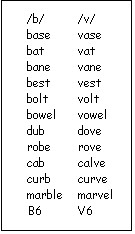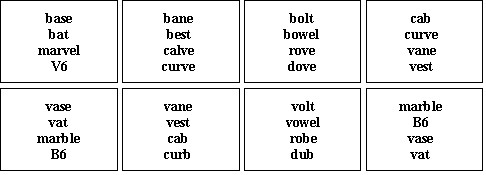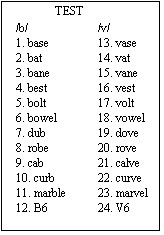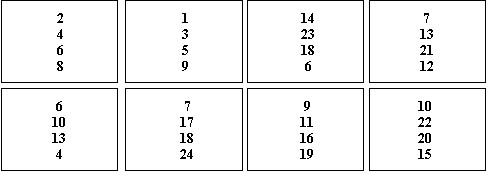
QUICK GUIDE
Key Words:Pronunciation practice, game
Learner English Level: From low beginner
Learner Maturity Level: Junior high school and above
Preparation Time: 20-25 minutes to select minimal pair, make handouts and placards
Activity Time: 10 minutes per class
Materials: whiteboard, index cards, and chopsticks to make placards
The cycle consists of four activities to focus on a specific set of English sounds that are difficult for Japanese learners, for example /b/ and /v/, and provide quick practice of them, involving student oral production and aural reception. They are also designed so that they do not take up more than 10 minutes of class time.
Select a pair of target sounds to practice and make a chart with 12 minimal pairs.

The words in this list should be used in all activities. Make placards by taping a colored index card to a pair of chopsticks. A separate color should be used for each of the target sounds (e.g., green for /b/ and red for /v/), allowing them to be used for multiple lessons.
Present the target sounds and minimal pair for practice to the class using the chart featuring the minimal pair. I have found drilling, using a listen-repeat-silent-repeat format, to be quick and effective (Helgesen, 2003). This step is the same for each activity.
Step 1: Presentation of the target (see instructions above).
Step 2: Place the students in pairs and give each a copy of the grid below. These text boxes can be easily made with any word processing program.

Step 3: Have Student 1 (S1) trace a path across the grid from Start to Finish. Note that the student should only go to hexagons that are directly across from the original one. They are not allowed to go up or down.
Step 4: Once S1 is finished, she should read her path to Student 2 (S2). S2 must trace the path according to the words she hears.
Step 5: Once they are finished, they should compare grids. The goal is to have the same path across the grid. When students compare grids, make sure they look at the words and not the lines in order to judge their accuracy. Just one incorrect word can make two completely different lines.
Step 6: Have the students switch roles and repeat the exercise on Side 2.
Step 1: Presentation of the target (see instructions above).
Step 2: Give each student a pair of placards (designate one color for each sound) and 3-4 word cards with a single word from the list on them each.

Put the students into small groups.
Step 3: Have S1 read one word to her group. The other students should raise the placard representing the sound they think they heard.
Step 4: Have S1 hold up the correct placard. The object is to get all members of the class or group to raise the correct placard.
Step 5: Have S1 finish all of her cards, then have each member of the group repeat steps 3-5.
Step 1: Presentation of the target (see instructions above).
Step 2: Put students into pairs. Give S1 a word card with four of the words from the list written on it.

Step 3: Have S1 read the words on the card and S2 write them on the whiteboard.
Step 4: Have the students check their accuracy by noting how many words written on the board are the same as those on the card.
Step 5: Give the students new cards, have them switch roles and repeat.
Step 1: Presentation of the target (see instructions above). This time each word on the chart should be assigned a number.

Step 2: Put the students into small groups. Give each student a card that has a set of four numbers on it.

Step 3: Have S1 read the words on the chart that correspond to the numbers on the card. The other students should then write down the number of the word that they heard.
Step 4: When S1 is finished, she should read the numbers on the card allowing other students to check their answers.
Step 5: Repeat until each student has had a chance to speak.
Hancock, M. (1995). Pronunciation games. Cambridge: Cambridge University Press.
Helgesen, M. (2003). Plan ahead: A do-it-yourself guide to helping your students think about what they will say. ETJ-Journal, 4(2), 1-5.